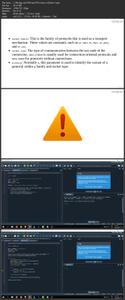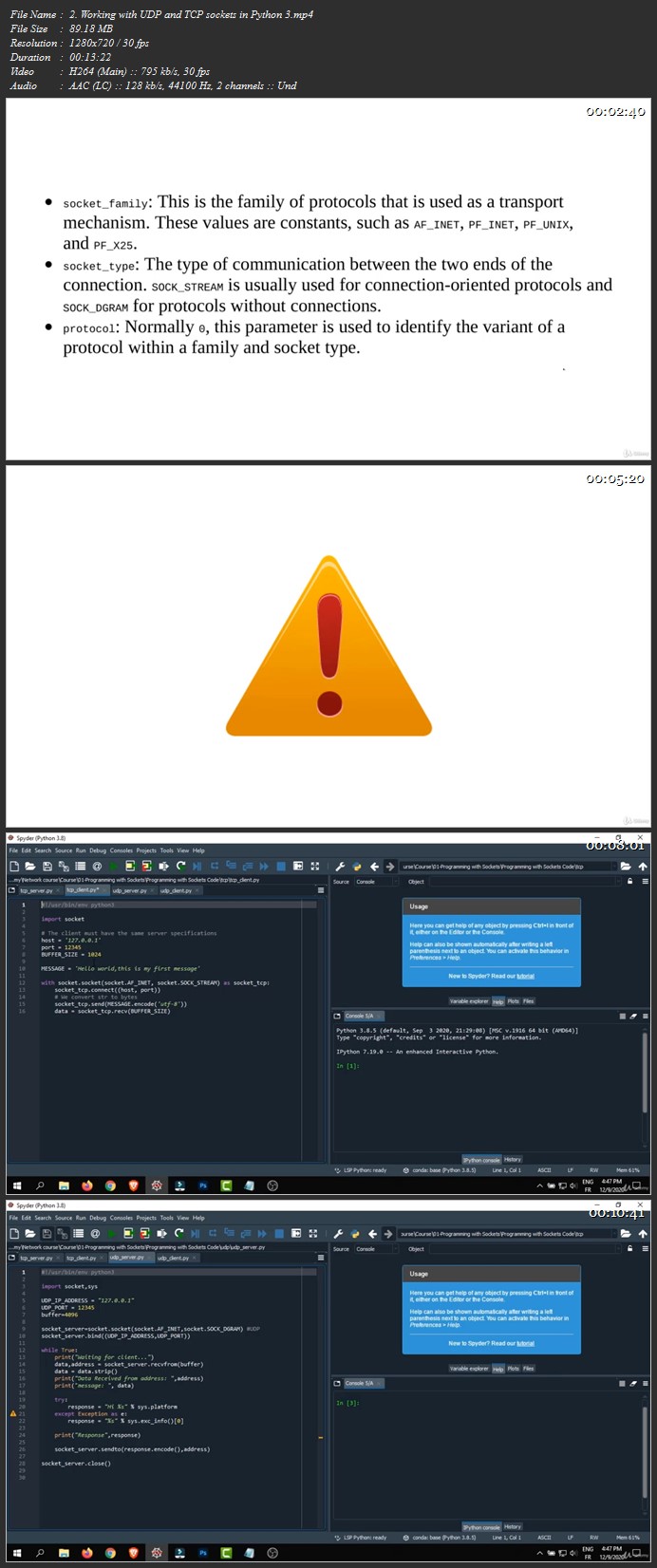Master Python Networking From A to Z - Part III : Advanced
Duration: 53m | .MP4 1280x720, 30 fps(r) | AAC, 44100 Hz, 2ch | 412 MB
Genre: eLearning | Language: English
Duration: 53m | .MP4 1280x720, 30 fps(r) | AAC, 44100 Hz, 2ch | 412 MB
Genre: eLearning | Language: English
Learn about Python network programming, networking protocols, hands on & build real-world network applications with ease
What you'll learn
Programming with Sockets, introduces the basics of sockets and the principles of UDP and TCP through examples involving the socket module with the IPv4 and IPv6 protocols. We will also cover non-blocking and asynchronous programming and HTTPS and TLS for secure data transport.
Designing Servers and Asynchronous Programming, covers the principles of socket-based server design and how to build small servers based on multiprocessing approaches. We review asyncio and aiohttp for asynchronous operations and other solutions, such as Tornado, Twisted, and Celery, for building asynchronous network applications.
Designing Applications on the Web, introduces the Django and Flask micro frameworks, which are designed to facilitate the development of web applications under the Model View Controller (MVC) pattern. Finally, we review how to work with HTTP requests in Flask and interact with databases through SQLAlchemy.
Requirements
Python Basics
The completion of "Master Python Networking from A to Z - Part I: fundamentals"
The completion of "Master Python Networking from A to Z - Part II: Intermediate"
Description
Network programming has always been a demanding task. With full-featured and well-documented libraries all the way up the stack, Python makes network programming the enjoyable experience it should be.
Starting with a walk-through of today's major networking protocols, throughout this course, you'll learn how to employ Python for network programming, how to request and retrieve web resources, and how to extract data in major formats over the web. You'll utilize Python for emailing, using a variety of protocols, and you'll interact with remote systems and IP and DNS networking. The connection of network devices and configuration using Python 3 will also be covered.
As the course progresses, socket programming will be covered, followed by how to design servers and the pros and cons of multithreaded and event-driven architectures. You'll develop practical client-side applications, including web API clients, email clients, SSH, and FTP. These applications will also be implemented through existing web application frameworks.
This course is ideal for Python developers or system administrators with Python experience who are looking to take their first steps in network programming.
Python developers who are interested in going deeper into packages related to asynchronous programming would also benefit from this course. A basic knowledge of Python programming is recommended.
This is the first course of the series, which will help you master the basics of the network programming before moving on to more advanced courses…
In this course we will cover the following:
Programming with Sockets, introduces the basics of sockets and the principles of UDP and TCP through examples involving the socket module with the IPv4 and IPv6 protocols. We will also cover non-blocking and asynchronous programming and HTTPS and TLS for secure data transport.
Designing Servers and Asynchronous Programming, covers the principles of socket-based server design and how to build small servers based on multiprocessing approaches. We review asyncio and aiohttp for asynchronous operations and other solutions, such as Tornado, Twisted, and Celery, for building asynchronous network applications.
Designing Applications on the Web, introduces the Django and Flask micro frameworks, which are designed to facilitate the development of web applications under the Model View Controller (MVC) pattern. Finally, we review how to work with HTTP requests in Flask and interact with databases through SQLAlchemy.
I hope you will enjoy This final part of the course and all the examples and real-world applications we are going to learn and create and if you have any questions or feedback please let me know!
Good Learning & Good luck
Who this course is for:
Python Programmers
IT Hobist and professionals who like to explore web technologies
Network administrators and managers
Agile developers interested in mastering network programming
Pen Testers and IT Security Professionals
More Info





